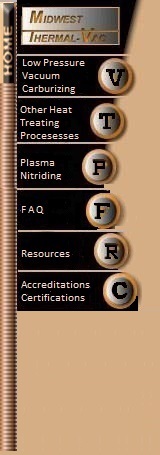

|
Low Pressure Vacuum Carburizing and Heat treating: Frequently Asked Questions
What advantages are there in Low Pressure Vacuum Carburizing?
The results are extremely reproducible. Many parts are repeatedly heat treated using the same process and noticeable variations are seldom seen. In fact, we find that any minor variances are usually created by different lots of steels from different manufacturers that our customers receive. Are there any harmful environmental issues with our processes? Vacuum carburizing and gas quenching, use inert Nitrogen gasses for creating a carbon neutral environment inside the furnace. The cooling system is a captive cooler that uses biodegradable glycol to keep things running cool. Simply put there are no environmental side effects to vacuum carburizing that still exist in many other heat treat processes. How much finishing stock do I need to leave on for grinding after the parts are vacuum carburized? Vacuum carburizing and gas quenching can offer the distinct advantage of creating a nearly virtual finished part that needs very little grinding or cleaning. By working closely with our customers and with proper recipe development, much of the post heat treat grinding stock, if not all of it, can be left off. This can offer considerable savings in overall post operation machining costs. Doesn’t heat treatment warp or distort the steel? The short answer is yes. There is no way to get around the fact that when steel is heated up to very high temperatures and rapidly quenched, the material does distort to some extent. However, the extent of distortion can be controlled by choosing the most efficient heat treat processes available. In an uncontrolled air atmosphere and by using separate quench methods, distortion can be excessive. Under vacuum with the addition of internal High pressure (up to 20 Bar) gas quenching, we see a very consistent or reproducible amount of movement per lot or load. This allows the manufacturer to plan all subsequent operations based on the knowledge that they are going to get a consistent part back. How do I choose Gas or oil quenching? Midwest Thermal-Vac works with customers very closely to understand their requirements. Optimal quench choices are decided based on part geometry, material type, hardness requirements, core hardness requirements or metallographic requirements. By utilizing Midwest Thermal-Vac’s experience with multiple quench capabilities for just about any material, we can assist our customers in choosing the optimal parameters to heat treat their parts based on solid experience that has been proven effective. Does Midwest Thermal-Vac only vacuum carburize? Midwest Thermal-Vac specializes in vacuum technology but is capable of performing just about all heat treating needs. Traditional heat treatments are employed such as tempering, austempering, normalizing, annealing, bright annealing, solution treating and spheroidizing. Why Plasma Nitriding? Plasma Nitriding will virtually eliminate part distortion or size change while providing these Metallurgical advantages:
Midwest Thermal-Vac works with customers very closely to understand their requirements. Recipes and processes are developed for each individual part need. Often times, development time of the approved process is greatly reduced because of our years of testing and experience. If there is a special requirement that needs to be met, Midwest Thermal-Vac will develop the process using closely monitored and controlled tests of actual parts. An effective and proven process will be developed and approved before the first production part is ever produced.
Low Pressure Vacuum Carburizing |
Heat Treat |
Plasma Nitriding |
Directory |
Resources |